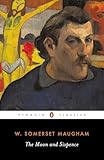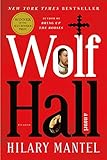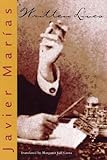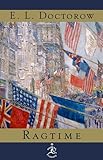Say “historical fiction,” and your listener’s eyes may glaze over, as you fight to re-seize attention. Younger readers or those with edgier tastes, especially, may associate authors of historical fiction with dotty academic types in tweed, or their narratives with conventional period dramas, the cinematic equivalent of which might be a Merchant Ivory production. So let me just say, with as much un-dotty enthusiasm as I can muster, that I am, like, way super excited about the histo-fi seminar I’m teaching this fall, “(Re)Imagining True Lives.”
More specifically, the reading list focuses on works of fiction that feature, either prominently or peripherally, real historical figures as characters:

 American Woman by Susan Choi
American Woman by Susan Choi
The Moon and Sixpence by W. Somerset Maugham
The Blue Flower by Penelope Fitzgerald
A Short History of Women by Kate Walbert
Regeneration by Pat Barker
Hadji Murad by Leo Tolstoy
Stories from You Think That’s Bad by Jim Shepard
Stories by Roberto Bolaño, Ursula K. Le Guin, and Colm Tóibín
Ragtime by E.L. Doctorow
Possible additions/substitutions:


 Written Lives by Javier Marías
Written Lives by Javier Marías
Libra by Don Delillo
The Master by Colm Tóibín
Wolf Hall by Hilary Mantel
The Book of Salt by Monique Truong
The News From Paraguay by Lily Tuck
(Now, if this list doesn’t get your reading chops watering, then sure, maybe historical fiction just isn’t for you.)
What fascinates me as both reader and writer (and also as teacher and lifelong writing student) is the always dynamic tri-level experience of delving into these works and their like; one is always simultaneously aware of 1) the author’s particular knowledge of and relationship (intellectual, political, emotional) to the real-life material; 2) one’s own particular knowledge of and relationship to (or lack thereof) the material; and 3) one’s engagement/response to 1).
Where has the author stayed close to “facts,” and where has she taken liberties of imagination, supposition, projection? Does my experience of the novel grow more, or less, deep and interesting as I identify the fact-fiction seams? Personally, I would say more – which is to say that, as we see the way in which researched and imagined history braid together, the author himself ultimately becomes a compelling character in his own right. As the author decides what to imagine/suppose/project (and of course how), he reveals, inevitably, his own concerns, ideas, obsessions.

 What is it about the German romantic poet Novalis’s rather banal, albeit eccentric, middle-class family and upbringing, and his courtship of the dull-witted 13 year-old Sophie von Kühn – years before he came into his full powers as poet and philosopher – that captivated Penelope Fitzgerald’s literary imagination? By what instinct or logic did both Susan Choi and Somerset Maugham take liberties in renaming their characters and revising their stories, while also rendering them clearly recognizable to the reader (as Paul Gauguin, and Patty Hearst and Wendy Yoshimura, respectively)? What do Bolaño and Le Guin mean by backgrounding primary figures like Borges and Cortazar, and the Arctic explorer Roald Amundsen, while foregrounding peripheral, fictional protagonists (the novelist Sensini in the story of the same name, and the all-female exploration team in “Sur”) in their stories of literary greatness and extreme adventure? Similarly, how important in the scope of history are figures like J.P. Morgan, Henry Ford, and Freud – in Doctorow’s literary vision – relative to a minor ragtime musician (the fictional Coalhouse Walker, Jr.), the Vaudeville escape artist Harry Houdini, and an immigrant street artist (also fictional), given Morgan’s and Ford’s relatively peripheral (at the same time utterly fascinating) scenes in Ragtime? What do Walbert’s imagined depictions of suffragette Dorothy Trevor Townsend’s female descendants tell us about her “what if” thought process (i.e., what if your mother, grandmother, great grandmother starved herself to death for a cause?) and conceptions of emotional inheritance? In other words, in their particular, idiosyncratic manipulations of history and imagination, and through our careful study of the results, these authors show us glimpses of not only their characters’ but also their own inner moral landscapes.
What is it about the German romantic poet Novalis’s rather banal, albeit eccentric, middle-class family and upbringing, and his courtship of the dull-witted 13 year-old Sophie von Kühn – years before he came into his full powers as poet and philosopher – that captivated Penelope Fitzgerald’s literary imagination? By what instinct or logic did both Susan Choi and Somerset Maugham take liberties in renaming their characters and revising their stories, while also rendering them clearly recognizable to the reader (as Paul Gauguin, and Patty Hearst and Wendy Yoshimura, respectively)? What do Bolaño and Le Guin mean by backgrounding primary figures like Borges and Cortazar, and the Arctic explorer Roald Amundsen, while foregrounding peripheral, fictional protagonists (the novelist Sensini in the story of the same name, and the all-female exploration team in “Sur”) in their stories of literary greatness and extreme adventure? Similarly, how important in the scope of history are figures like J.P. Morgan, Henry Ford, and Freud – in Doctorow’s literary vision – relative to a minor ragtime musician (the fictional Coalhouse Walker, Jr.), the Vaudeville escape artist Harry Houdini, and an immigrant street artist (also fictional), given Morgan’s and Ford’s relatively peripheral (at the same time utterly fascinating) scenes in Ragtime? What do Walbert’s imagined depictions of suffragette Dorothy Trevor Townsend’s female descendants tell us about her “what if” thought process (i.e., what if your mother, grandmother, great grandmother starved herself to death for a cause?) and conceptions of emotional inheritance? In other words, in their particular, idiosyncratic manipulations of history and imagination, and through our careful study of the results, these authors show us glimpses of not only their characters’ but also their own inner moral landscapes.
How we read these works also reveals to us something about our own relationship to fact and fiction. To what degree am I aware of divergences from strict facts as I am reading? Do I give myself over to the whole of the created world and characters, or do I pause to ask myself, “Did this really happen?” and then click over to Google to fact-check? Or do I engage in this research afterwards? Or not at all? Why, or why not?
We read a memoir, a la James Frey’s A Million Little Pieces, and take it for true, only to learn that key elements have been fabricated, embellished. We are offended, insulted, maybe impressed, maybe not so surprised. But what of the converse? You are reading an absurd or incredible scene in a novel (the episode in Ragtime where J.P. Morgan sleeps solitary in the crypt of an Egyptian pyramid comes to mind), and then come to find it really happened. What is the effect, then? The other day I was walking in the park and saw, in a pond, a bronze sculpture of a turtle, nose in the air, perched on a rock. How quaint, I thought. Then, movement in the water: an actual turtle swimming, nosing up to the sculpture, trying to get its attention. Silly, dumb thing, I thought. Then, the sculpture’s eyes – black on white with blood-red outlines – suddenly flickered; the turtle stretched its neck even longer up toward the sun, then twisted to acknowledge its suitor-compadre. I stood there a few moments, smiling stupidly.
What was the nature of my delight? The translucent hologram of truth and falsity, real and fake, shifting and melding, captivates. In the hands of a skillful and mindful artist, the effect is unsettling and exciting: we start out on a smooth, hard path, but then find our feet sinking into warm sand, or slipping on ice, at times finding again stone-solid footing, only to slip or sink again. Where are we? Whose reality is this? History, the author’s inventiveness and fixations, our own projections and obsessions call out to us all at once. In historical fiction, studied closely, perhaps more so than with other sub-genres, this motional holographic magic comes into stark relief – not unlike the red flickering eyes of a turtle or, one hopes, the un-dotty aha moments of a seminar-class discussion. For good measure, maybe I’ll show up on the first day wearing gold lamé and skinny jeans.








